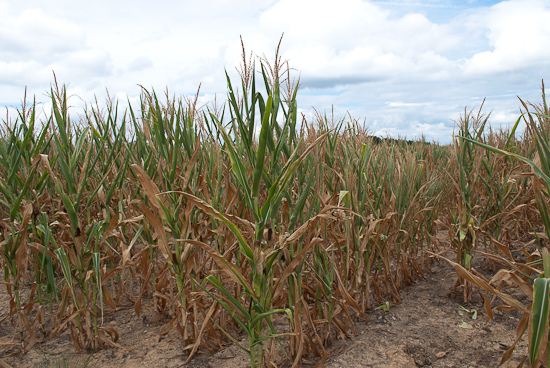Drought forces farmers to rethink plans for corn crop
Drought forces farmers to rethink plans for corn crop

Published on July 19, 2012
According to Kentucky Weekly Crop and Weather Report for the week ending July 15, 77 percent of the state’s corn crop was rated poor or very poor. While rain is needed, it may do little to help the crop as 90 percent of it has already tasseled and 76 percent has silked.
“As far as harvesting a crop, this is the worst I’ve seen since I’ve been here,” said Susan Fox, who’s been Lyon County’s agriculture and natural resources agent with the University of Kentucky Cooperative Extension Service for the past seven years. “The timing of the extreme heat combined with severe drought at tasseling was terrible for corn pollination.”
Since March, the nearest weather station in Princeton has received 8.45 inches of rain, which is 14.39 inches below normal rainfall totals, said Tom Priddy, UK agricultural meteorologist.
Some of the producers in Lyon County have made the decision to cut at least a portion of their crop for silage to feed to their livestock.
Given the drought and the condition of the corn, UK College of Agriculture specialists agree that making silage from the crop to feed to ruminants can be a viable option for farmers. Drought-stressed corn harvested for silage can be 60 to 100 percent of the normal feed value of regular corn silage, depending on how much of the crop was damaged and the amount of grain in the silage.
Lyon County farmer Jackie Millikan normally chops 50 to 75 acres of his corn crop for silage every year to feed to his 300 head of cattle. This year, he will likely harvest 100 to 125 acres for silage.
“With the drought situation, it is taking more acres to get the same amount of silage,” he said. “We will start feeding silage earlier. We don’t have as much hay, so we will have to feed more silage. Everything is burned up.”
In addition to greatly reducing corn yields, the drought has deteriorated pasture conditions. As a result, Millikan has been feeding hay to his herd since May. Lyon County isn’t alone, as the Kentucky Crop and Weather Report rated 73 percent of the state’s pastures in poor to very poor condition. This may make silage more attractive to producers, as it could provide an additional feed source to get their animals through the winter.
Across the county, Bill Holsapple made the decision to cut all 100 acres of his corn crop for silage.
“I walked every 100 feet from one end of the field to the other until I walked the whole thing, and then I decided whether to shell the corn or make silage,” Holsapple said. “We think silage is our best situation; there’s no question about it.”
He and his cousin David Williams will revive some old silage trenches their fathers utilized to feed cattle many years ago, and they will buy cattle to feed this winter with the goal of selling them in late winter or early spring.
“It may work and it may not, but sometimes you’ve got to do something. You’ve got to try,” Williams said.
Before harvesting corn for silage, UK specialists encourage producers to contact their crop insurance agent so they understand the rules and choices associated with silage in their policy.
Corn should be harvested for silage when the moisture content is between 60 to 70 percent depending on the storage method. Producers should test each field for nitrate levels to determine which fields to cut for silage. Heat and drought can make nitrate levels higher, especially in the lower third of the plant. High nitrate levels could result in nitrate poisoning of livestock. Silage should ferment four to six weeks. The fermentation process will considerably lower nitrate levels, but producers should have their silage tested again after fermentation is complete before feeding it to animals.
The UK Veterinary Diagnostic Laboratory performs forage nitrate/nitrite testing. The cost is $15 per sample. Producers can take samples to their county extension agent or send them directly to the lab. For more information on how to collect a sample for nitrate testing, visit http://www.uky.edu/Ag/GrainCrops/Briefs/nitrate_testing2012.html. More information on harvesting corn for silage, baleage or hay is available at http://graincrops.blogspot.com/2012/07/considerations-for-harvesting-drought.html. For more information on the drought in Kentucky, visit the Kentucky Drought Resources Web page at http://drought.ca.uky.edu/.
Agricultural Economics Extension Weather



